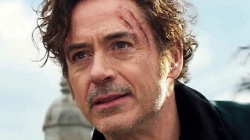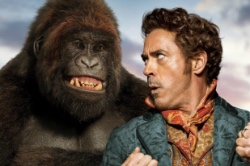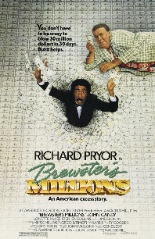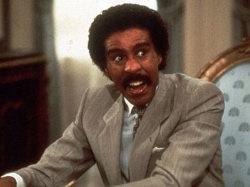
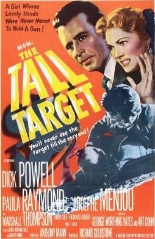 The Tall Target takes place on the eve of President-elect Abraham Lincoln’s inauguration, but don’t let its 1861 setting fool you. This crime drama, loosely based on an actual plot to kill Lincoln, is more film noir than period piece, albeit with bushy mustaches and talk of secession replacing fedoras and hard-boiled dialogue.
The Tall Target takes place on the eve of President-elect Abraham Lincoln’s inauguration, but don’t let its 1861 setting fool you. This crime drama, loosely based on an actual plot to kill Lincoln, is more film noir than period piece, albeit with bushy mustaches and talk of secession replacing fedoras and hard-boiled dialogue.
But I digress. Dick Powell stars as New York police Sgt. John Kennedy – yes, John Kennedy (cue the conspiracy mongers) – who has caught wind of a plot to assassinate Lincoln shortly before the inauguration in Washington. Problem is, Kennedy’s supervisor doesn’t believe him, or even much care. Unable to get word to the incoming president, the intrepid detective boards a Baltimore-bound train where he plans to meet up with his partner and track down the assassin he believes is on board.
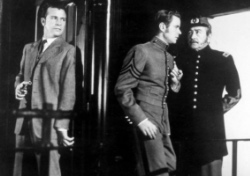 The conspiracy is already afoot. Kennedy discovers his partner has been murdered, and Kennedy’s seat is now occupied by a burly imposter claiming to be Kennedy. Luckily our hero knows another passenger, Army Col. Caleb Jeffers. The colonel promises to help Kennedy stop the plot but, then again, Jeffers is played by Adolphe Menjou, and anyone who has seen Adolphe Menjou in an old movie knows he is not to be trusted.
The conspiracy is already afoot. Kennedy discovers his partner has been murdered, and Kennedy’s seat is now occupied by a burly imposter claiming to be Kennedy. Luckily our hero knows another passenger, Army Col. Caleb Jeffers. The colonel promises to help Kennedy stop the plot but, then again, Jeffers is played by Adolphe Menjou, and anyone who has seen Adolphe Menjou in an old movie knows he is not to be trusted.
Director Anthony Mann helmed solidly made film noirs and Westerns, and Tall Target finds a compelling sweet spot between the two genres. Mann keeps things brisk and lean – the lack of a music score heightens the tension – and thick with paranoia. With the country on the verge of civil war, the film vividly builds an atmosphere where corruption is pervasive and tempers are simmering. It also benefits from a strong cast, particularly Leif Erickson as the bogus John Kennedy and a young Ruby Dee as a slave traveling with a brother-sister combo from the South. —Phil Bacharach

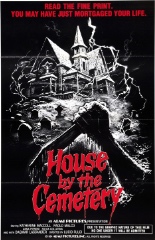
 Have you ever noticed that many of the children in Italian horror films are just as unappealing as the grotesque monster attacking them?
Have you ever noticed that many of the children in Italian horror films are just as unappealing as the grotesque monster attacking them?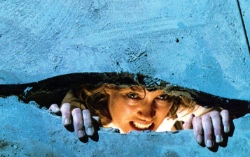
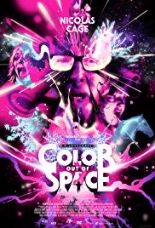
 H.P. Lovecraft’s short story “
H.P. Lovecraft’s short story “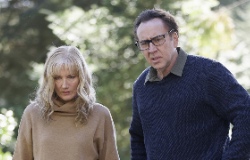
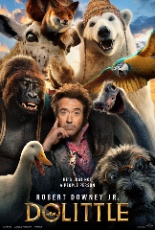
 If man could talk to the animals, what conversations would we have? Personally, I’d like to engage my family’s nearly blind, nearly deaf Shih Tzu, Emmy, in a discussion of the hole she has scratched into the side of her neck. We didn’t notice it until the smell of death wafted from across the living room; upon closer examination, we discovered a nauseating, John F. Kennedy half-dollar-sized crater of flesh and blood and gunk of unspeakable coloring, with a newly burst abscess that screamed infection. Frankly, four rounds of antibiotics later, I’d like to ask her what the hell she was thinking.
If man could talk to the animals, what conversations would we have? Personally, I’d like to engage my family’s nearly blind, nearly deaf Shih Tzu, Emmy, in a discussion of the hole she has scratched into the side of her neck. We didn’t notice it until the smell of death wafted from across the living room; upon closer examination, we discovered a nauseating, John F. Kennedy half-dollar-sized crater of flesh and blood and gunk of unspeakable coloring, with a newly burst abscess that screamed infection. Frankly, four rounds of antibiotics later, I’d like to ask her what the hell she was thinking. 